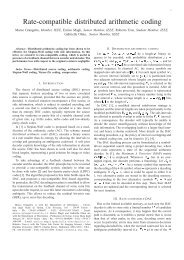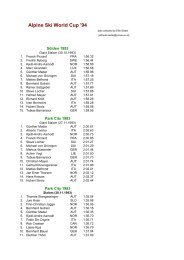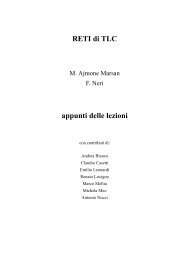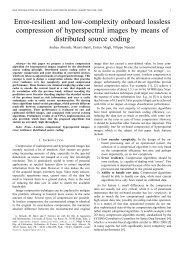Transform coding techniques for lossy hyperspectral data compression
Transform coding techniques for lossy hyperspectral data compression
Transform coding techniques for lossy hyperspectral data compression
You also want an ePaper? Increase the reach of your titles
YUMPU automatically turns print PDFs into web optimized ePapers that Google loves.
IEEE TRANSACTIONS ON GEOSCIENCE AND REMOTE SENSING (SUBMITTED DEC. 2005) 11<br />
akin to per<strong>for</strong>ming a 3D rate-distortion optimization, which is known to provide significantly better<br />
results than band-by-band optimization [16].<br />
The per<strong>for</strong>mance evaluation is carried out on 16-bit radiance AVIRIS <strong>data</strong> cubes. AVIRIS scenes<br />
have 224 bands and 614 × 512 pixels resolution, but each scene has been cropped to 256 × 256 × 224<br />
pixels. Scene 4 of Cuprite and scene 3 of Jasper Ridge have been employed; <strong>for</strong> brevity, we only<br />
report the set of results <strong>for</strong> Cuprite.<br />
B. Energy compaction results<br />
For clarity, in Tab. I we summarize the acronyms used in the figures to identify the eight 3D<br />
trans<strong>for</strong>ms that have been evaluated.<br />
TABLE I<br />
ACRONYMS OF THE EVALUATED TRANSFORMS<br />
Acronym<br />
DWT3D<br />
DWP3D<br />
DWT1D2D<br />
DWP1D-DWT2D<br />
DWP1D-DWP2D<br />
DWT1D-DWP2D<br />
DCT1D-DWT2D<br />
KLT1D-DWT2D<br />
Sect.<br />
II.E.1<br />
II.E.2<br />
II.E.3<br />
II.E.4<br />
II.E.5<br />
II.E.6<br />
II.E.7<br />
II.E.8<br />
We anticipate that, not surprisingly, we have found that the spectral correlation plays a crucial role<br />
<strong>for</strong> <strong>compression</strong>, since the trans<strong>for</strong>ms that are better able to capture this correlation are those that<br />
rank best <strong>for</strong> <strong>compression</strong>. It is already known <strong>for</strong> lossless <strong>compression</strong> (see e.g. [25]) that large<br />
bit-rate reductions can be achieved by employing an efficient model of the spectral correlation. As<br />
will be seen, exploiting this correlation in the <strong>lossy</strong> case calls <strong>for</strong> the use of separate spectral and<br />
spatial trans<strong>for</strong>ms.<br />
In Fig. 5 we compare the DWT3D and DWP3D trans<strong>for</strong>ms. Neither trans<strong>for</strong>m is computed<br />
separately in the spectral dimension. As can be seen, the rate-distortion curve of the DWP3D trans<strong>for</strong>m<br />
is significantly better than that of the DWT3D. This is due to the fact that the 3D square wavelet<br />
trans<strong>for</strong>m is isotropic in all three dimension. This may not be the most appropriate correlation model<br />
of a <strong>hyperspectral</strong> <strong>data</strong>set, since the subband decomposition in the spectral dimension is not as fine as<br />
it could be. Hence, because of the rather rough tessellation of 3D frequency space, the DWT3D turns






